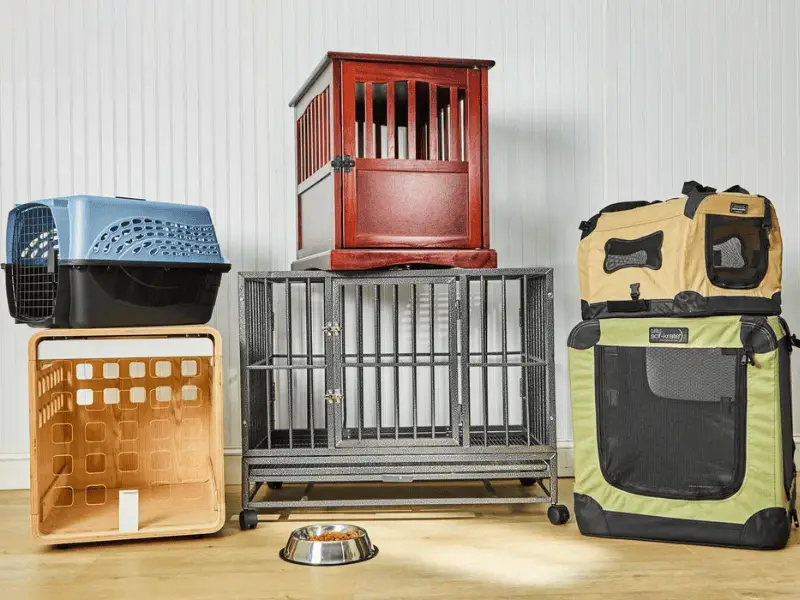Though it may come as a surprise, a Dog Neck Size Chart can vary so widely that the smallest dog necks measure barely 6 inches, while the largest can reach up to an astounding 28 inches!
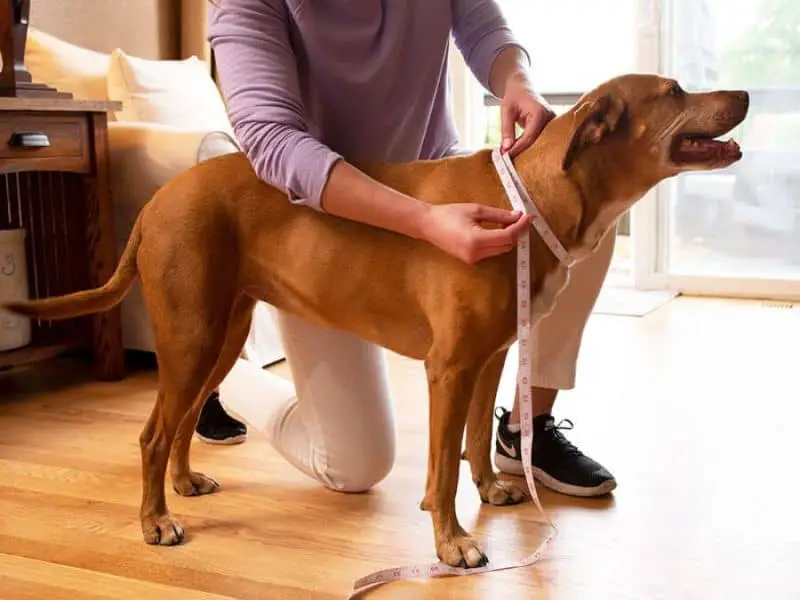
Understanding the Importance of Proper Dog Collar Fitting
Properly fitting a dog collar is crucial for their safety and comfort. In this section, we’ll explore why a well-fitted dog collar is essential and the potential consequences of a collar that is either too tight or too loose. With facts and insights from our reference data, we’ll reveal the importance of finding the right balance to ensure your furry friend’s well-being.
Importance of a well-fitted dog collar for safety and comfort
A well-fitted dog collar is important for the safety and comfort of our canine pals. It is essential to have one that fits correctly so there is no discomfort or injury. If the collar is too tight, it can be uncomfortable and even hurt the pup.
If it is too loose, it may slip off or let the pup escape. So, ensuring the collar fits snugly around their neck is vital without restricting their breathing or movement.
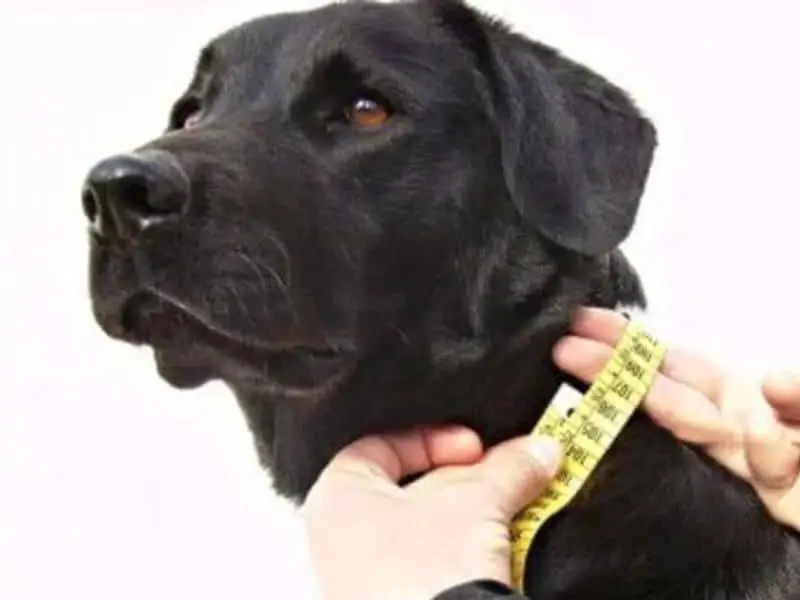
Collars that fit properly provide security on walks and outings and prevent accidents or harm. To get a perfect fit, accurately measure the pup’s neck with a soft measuring tape. Add two inches when selecting the collar size for extra room.
This allows for growth or weight changes without compromising the snugness of the fit. Plus, there should be enough space between the collar and the pup’s neck for two fingers to fit comfortably. This guarantees the collar isn’t too tight and provides proper airflow.
Dog Neck Size Chart: Discover the Surprising Range in Canine Neck Sizes
Choosing the right collar size and type depends on things like breed, size, and needs. Different breeds may have different requirements, and medium-sized dogs may need narrower collars compared to bigger breeds.
It is also essential to check the fit of the collar regularly as pups grow or experience weight changes. This ensures they always wear a properly fitted collar that ensures safety and comfort.
A well-fitted collar is necessary for the safety and comfort of our four-legged friends. By taking the time to measure and choose the right size collar, we can ensure our pups are protected on walks and outings, and avoid any potential accidents or harm.
Consequences of a collar that is too tight or too loose
Collar fit has serious consequences for a dog’s safety and comfort. Too tight and it can cause discomfort, chafing, and even injury. Loose collars slip off easily, risking the dog getting lost or injured. They can also get caught on objects or in the mouth, causing accidents or choking.
It is crucial to ensure the collar fits properly. A tight one restricts movement and breathing, creating pressure points. It can affect alignment of the dog’s spine too. A loose collar gives more freedom but also increases risk of accidents and injuries.
To prevent these negative effects, check and adjust fit regularly. Weight or growth spurts can change how it fits. Measure the neck circumference accurately, use appropriate sizing options, and check space between collar and neck. Pay attention to these details to avoid the consequences of an ill-fitting collar. Measure twice, collar once for the perfect fit!
Dog Neck Size Chart: How to Measure Your Dog’s Neck for a Perfect Fit
Measuring your dog’s neck for a perfect fit is crucial to ensure their comfort and safety. In this section, we’ll provide you with a step-by-step guide on how to measure your dog’s neck circumference accurately.
We’ll also discuss the importance of adding two inches to determine the ideal collar size and how to ensure the right amount of space between the collar and your dog’s neck. Your furry friend deserves a collar that fits just right, and we’ll show you how to achieve it.
Step-by-step guide to measuring your dog’s neck circumference
A well-fitted collar is key for your pup’s safety and comfort. Too tight and they’ll be uncomfortable, too loose and it could slip off. Get the right fit by measuring their neck circumference. Here’s how:
- Wrap a flexible tape or string around the neck at the spot where the collar usually sits.
- Make sure it’s snug but not too tight.
- Record the measurement in inches or centimeters.
- Add two inches (5 cm) for the ideal size.
Check the fit regularly as size can change due to growth or weight. Consider breed, size and activity level when choosing a type of collar. Narrow for small dogs, wider for larger ones. Options include leather for style, neon for visibility, all-weather for active dogs, and handled for control.
For your pup’s sake, give extra breathing room with two inches for the collar.
Adding two inches for the best collar size
Adding two inches to your pup’s neck measurement is essential for the perfect collar size. This extra space provides comfort and flexibility, averting potential discomfort and restriction. It also gives room to adjust as your fur-baby grows or gains weight.
Adding two inches for the best collar size:
- Use a flexible tape measure to measure your pup’s neck.
- Make sure the tape isn’t too tight.
- Add two inches to the measurement obtained.
- Choose a collar that matches this size.
- Fit the collar on your pup and ensure there’s enough space between the collar and neck.
- You should be able to fit two fingers between them.
Two inches gives a snug fit, taking into account any changes in fur length or weight. It allows for proper adjustability and prevents any constrictions or discomfort from a too tight collar.
Ensuring the right amount of space between the collar and the dog’s neck
- Use a flexible tape measure to measure your dog’s neck circumference at the base of the neck.
- Add two inches to find the correct collar size. This extra space allows for movement without constriction.
- Check that there’s enough room by inserting two fingers flat against their skin. This gap allows proper airflow and prevents chafing.
- Adjust the collar by tightening or loosening until desired spacing is achieved.
- Regularly check the fit as the dog grows or changes weight. You may need to adjust it.
The right amount of space between the collar and the dog’s neck is key for comfort and safety. It’s not only about measuring but also monitoring and adjusting. This attention ensures comfort and reduces risks of an ill-fitting collar. Checking this aspect of the accessories contributes to your dog’s well-being and keeps style and function in your life together.
Choosing the Right Collar Size and Type for Your Dog
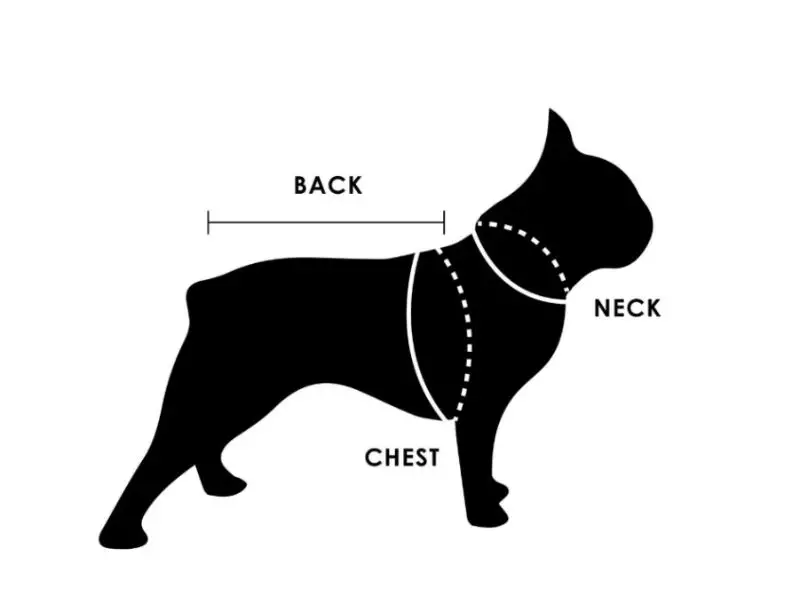
Choosing the right collar size and type for your beloved furry friend is crucial for their comfort and safety. In this section, we will explore different sizing options and considerations for dogs of various sizes.
We will also discuss recommended collar widths based on the size of your dog. Additionally, we’ll emphasize the importance of regularly checking the collar fit as your dog grows or changes weight. Let’s ensure that our canine companions are comfortable and stylish with the perfect collar choice.
Different sizing options and considerations for small, medium, and large dogs
For small doggos, it’s really important to consider their delicate necks when picking a collar. Choose a narrow width to give them support without discomfort.
Medium-sized pups need collars that balance strength with comfort. Slightly wider ones are good for pressure distribution.
Large canine pals need sturdy collars to withstand their strength and provide control. Wider widths will also give them extra durability.
Don’t forget weight when selecting the size of the collar. Heavier dogs might benefit from wider collars while lighter doggos might like narrower ones more.
The material of the collar is another important thing to think of. Lightweight nylon collars are good for small or medium-sized dogs, while large canines may want stronger materials like leather or reinforced fabric.
Accurately measure the doggo’s neck circumference before picking a size. This way, it’ll fit snugly, reducing the risk of injury or escape.
Always remember to check the collar fit regularly as the pup grows or changes weight. If it’s too tight or loose, it could compromise safety and comfort. Monitor the fit and adjust if needed!
Pro Tip: When selecting a size for your pup, factor in their current measurements and potential growth. Add an extra inch or two to the neck circumference to give them room to grow and keep them safe and comfy.
Finding the perfect collar width for your furry friend – because a fashion faux-paw is just collar crime!
Recommended collar widths for different-sized dogs
Size is vital when selecting a collar for your pup. Ensure comfort and safety by picking the correct width. Consider the size and weight of your pup when choosing.
- Small dogs: 0.5 to 0.75 inches.
- Medium dogs: Around 1 inch.
- Large dogs: 1.5 inches.
- Giant dogs: At least 2 inches.
- Puppies: An adjustable width.
Too narrow a collar may put excessive pressure on your pup’s neck, leading to discomfort or injury. Too wide a collar may not provide the right support. Pick the ideal width to give your pup the perfect balance of comfort and function.
Pro Tip: Measure your pup’s neck accurately before buying a collar. Use a flexible measuring tape or string and add two inches to the measured length. Check regularly as your pup grows or changes weight.
Checking the collar fit regularly as the dog grows or changes weight
It’s important to keep your pup comfy and safe, so assess their collar fit often. Neglecting this can lead to irritation or injury. Here’s how:
- Measure your dog’s neck with a flexible tape.
- Slip two fingers under the collar and check if there’s still space.
- If it doesn’t fit, get a new one!
- Monitor the fit as your pup grows or changes weight, and adjust it properly – not too tight, not too loose!
There’s the perfect collar for any pup – from leather to weather-proof!
Exploring Different Types of Dog Collars for Various Needs
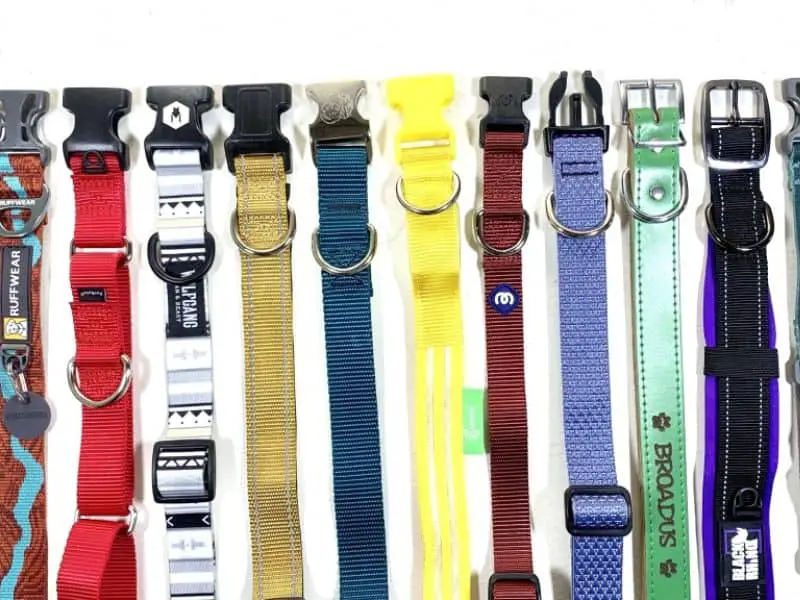
Discover the world of dog collars tailored to meet your furry friend’s specific needs. From leather collars exuding durability and style, to neon and luminous options ensuring visibility during evening walks, we have it all covered.
Looking for all-weather collars that can keep up with your active pup? Or perhaps a handled collar for better control in off-lead situations? We even have an extensive range of official JULIUS-K9® collars to choose from. Let’s explore the diverse realm of dog collars!
Leather collars for durability and a stylish look
Leather collars for dogs are a hit with owners that want both sturdiness and style. Known for their high-quality materials, these collars can take everyday wear and tear.
Plus, the fancy look of leather collars adds sophistication to your pup’s look. You can pick from a variety of designs and colors to match your dog’s personality and style. Furthermore, leather collars are softer on the neck, providing comfort.
It is essential to maintain leather collars to keep them in good shape. Cleaning with suitable leather care products will help maintain the collar’s quality and extend its lifetime. By taking care of your leather collar, you get durability and a fashionable look for your pet.
Besides leather, you can light up the night with neon and luminous collars. Safety is essential and should never be sacrificed for style.
Neon and luminous collars for visibility during evening walks
Neon and luminous collars are designed to make your pup visible in low light conditions – perfect for evening walks! They come in various colors and styles, and provide a way to stay safe. Here’s how to use them effectively:
- Check the size and fit of the collar for your pup’s comfort.
- Add reflective accessories like leash attachments or harnesses for extra visibility.
- Use a flashing LED light attachment if you’re near roads or high-traffic areas.
- Keep the collar clean to maintain visibility.
- Choose hypoallergenic materials if your pup has sensitive skin.
These collars are essential for nighttime safety. They help prevent accidents, and make sure your pup is seen by pedestrians and drivers. It’s important to regularly check the condition of the collar and replace it if needed – wear and tear can affect its visibility-enhancing properties over time.
All-weather collars for active dogs and easy maintenance
All-weather collars are perfect for active dogs! Crafted from durable materials, they are resistant to water, dirt, and other elements your dog may encounter outdoors. Plus, they offer easy maintenance, so you can save time and effort. Features like adjustable straps and luminous elements make them a great choice for all seasons.
When selecting one, consider your dog’s activities and environment. Opt for waterproof materials for the best longevity, plus adjustable features for the perfect fit and comfort.
Handled collars for better control in off-lead situations
Handled collars provide an extra layer of security when out and about with your pup. They have a handle or loop that lets you get a secure grip on their neck. This makes it easier to grab them in emergencies or when needed, and prevents them from running into danger.
These collars come in different materials and designs, suitable for different breeds and sizes. They are especially useful for training, giving trainers better control over their dog’s movements.
Not only can these collars be practical, but they also offer peace of mind. The risk of accidents or incidents is reduced during off-leash activities.
History reveals that these collars were originally designed for military and police dogs. Over time, their effectiveness made them popular among dog owners and trainers. Now, handled collars are an essential tool for maintaining control of dogs in off-lead situations.
Dog Neck Size Chart: Ensuring a Perfect Fit for Your Dog’s Collar for Safety and Style
Ensuring the perfect fit for your dog’s collar is essential for both their safety and style. In this conclusion, we will explore the importance of choosing the right collar size and type, the significance of regularly checking the collar fit for your dog’s well-being, and provide contact and help resources to address any questions or concerns you may have. Let’s make sure your furry friend is comfortable, secure, and looking their best!
Importance of choosing the right collar size and type for your dog
Choosing the right collar for your pup is vital. It keeps them safe and comfy. A snug fit minimizes the risks of accidents or escapes. Plus, it prevents any soreness or pain from being too tight or too loose. Ill-fitting collars can lead to skin irritation, hair loss, and injuries or choking. So, finding the perfect fit for your dog’s neck circumference is important.
Start by measuring their neck circumference with a flexible tape measure. Wrap it around their neck, and add two inches. This allows for comfy movement without compromising security. Check the space between the collar and the neck. Should be room for two fingers. This ensures a secure but not restrictive fit.
When selecting the right collar, consider their breed, size, and needs. Different sizes cater to small, medium, and large dogs. Also, check the recommended width based on their size. This offers optimal support and comfort.
Regularly check their collar fit as they grow or change. This prevents any discomfort or hazards from an ill-fitting collar. Taking these steps will keep your pup safe, secure, and stylish on all their adventures.
Checking the collar fit regularly for your dog’s safety and comfort
A snug collar is key to your pup’s safety and comfort. Check it regularly to make sure it’s not too tight or too loose. Too tight can restrict breathing, and cause discomfort and neck injury. Too loose may come off, leading to accidents or loss. Regular checks can prevent this!
- Checking its fit also helps in proper training and behavior management.
- It allows for better control during leash corrections and off-lead activities.
- Make adjustments or replacements as your pet grows/changes weight.
- Be vigilant and inspect the collar’s snugness on your pup’s neck.
Don’t overlook checking the fit of your dog’s collar. Address any issues promptly for their safety and well-being. That’s the way to ensure a comfortable fit!
Contact and help resources for any questions or concerns
Seeking expert advice is the best way to ensure your pet’s safety and comfort when it comes to fitting dog collars. Consult with a veterinarian or a professional dog trainer for more specific inquiries. They possess the expertise to address unique situations and provide tailored advice.
You can also find answers to common concerns through online resources. Websites dedicated to pet care and accessories often have comprehensive guides on proper collar fitting. These can be accessed at any time from the comfort of your own home.
When in doubt, prioritize your pet’s safety and comfort by seeking professional help. Reach out to qualified individuals, so any questions or concerns about dog collar fitting can be effectively addressed.
Some Facts About Fitting it Right: A Guide to Dog Neck Size:
- Proper collar fit is important for a dog’s health and safety.
- Measure your dog’s neck using a tape measure to fit the collar comfortably around the neck, allowing two to three fingers to fit easily under the tape.
- For clothing and neckwear accessories like bandanas, it is recommended to use a neck measurement taken a bit lower than collar level (closer to the withers) for a more flattering fit.
- To determine the correct collar size, measure the center of the dog’s neck a few inches down from its head using a cloth tape measure or string.
- The Canny Collar is a dog walking collar that comes in different sizes. To determine the correct size for your dog, you need to measure its neck.


